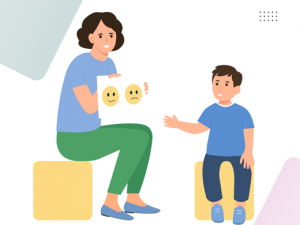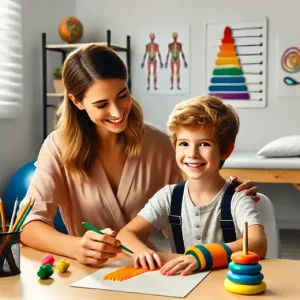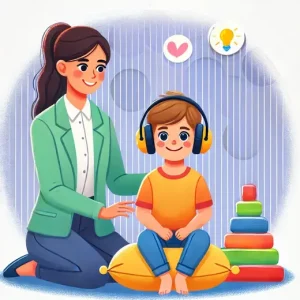Integrated Yoga Therapy for teaching Toothbrushing skills | Children with ASD
By Prapoorna M
Last Updated: November 27, 2021
For many children with Autism Spectrum Disorder (ASD), daily routines like toothbrushing can be a mountain to climb rather than a molehill. These challenges often stem from sensory sensitivities – either too much or too little stimulation in the mouth can turn what should be a simple task into an overwhelming ordeal. Traditional methods, while effective for some, often don’t bridge the gap for those who struggle with the manual dexterity and sensory processing that toothbrushing requires.
Enter Integrated Yoga Therapy – a beacon of hope for parents and caregivers seeking alternative and supportive methods to teach essential life skills. At its core, this approach is more than just yoga; it’s a holistic strategy that marries the physical benefits of yoga with the therapeutic potential to enhance focus, reduce sensory overload, and improve overall coordination.
Also Read: Oral Motor Exercises: Jaw Exercises for Effective Communication
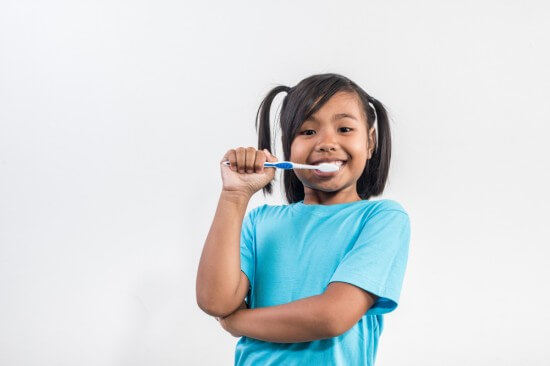
Understanding ASD and Oral Health
Autism Spectrum Disorder (ASD) is a condition that touches many aspects of a person’s life, from the way they interact with the world around them to the mastery of daily life skills. One area that often poses a challenge for individuals with ASD is maintaining oral health. This challenge isn’t just about keeping teeth clean; it’s about navigating the sensory experiences associated with toothbrushing, the coordination required to use a toothbrush effectively, and understanding the importance of oral hygiene for overall health.
Children with ASD may experience a range of sensory sensitivities that make the textures, tastes, and sensations of toothbrushing overwhelming. This can lead to difficulties in establishing a regular oral hygiene routine, which is crucial for preventing dental problems. Moreover, the manual dexterity required for effective toothbrushing may be harder to develop in children with ASD, adding another layer of complexity to their oral health care.
The importance of addressing these oral health challenges cannot be overstated. Poor oral hygiene can lead to a host of dental issues, such as cavities, gum disease, and discomfort, which in turn can affect eating habits, self-esteem, and overall well-being. It’s not just about teeth; it’s about quality of life.
The Limitations of Traditional Methods
When it comes to teaching children with Autism Spectrum Disorder (ASD) the essential skill of toothbrushing, traditional methods like Visual Pedagogy (VP) and Video Modeling (VM) have been the go-to strategies. These methods rely on the visual strengths of children with ASD, utilizing step-by-step demonstrations and repetitive viewing to teach various skills, including oral hygiene practices. However, while VP and VM are effective for many, they might not address the unique needs of every child with ASD.
Read about our article on Virtual Autism: Things that you need to know
Visual Pedagogy and Video Modeling: A Closer Look
Visual Pedagogy involves the use of images, symbols, and other visual aids to communicate and teach. Video Modeling, on the other hand, uses video recordings to demonstrate behaviors or skills to be learned, allowing the viewer to observe and then imitate the action. These methods leverage the visual learning capabilities of children with ASD, making them powerful tools for teaching a range of skills.
Also Read: Visual Communication and Autism: The Power of Visual Schedules
The Gap in Traditional Approaches
Despite their advantages, these visual strategies often overlook the sensory sensitivities and motor skill challenges that many children with ASD face. For instance, children with tactile defensiveness or hypersensitivity may find the sensation of a toothbrush against their gums overwhelming, leading to resistance or avoidance of toothbrushing altogether. Similarly, children with motor planning difficulties might struggle to translate what they see in videos into physical actions.
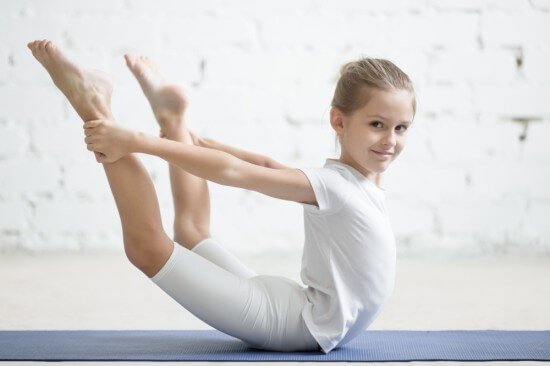
Integrated Yoga Therapy:
Integrated Yoga Therapy transcends traditional practices by incorporating a blend of physical postures, breathing techniques, and mindfulness practices tailored to meet the unique needs of children with ASD. This therapeutic approach aims to harmonize the body, mind, and spirit, facilitating a deeper connection within oneself and the surrounding world. The benefits of IYT for children with ASD are multifaceted, ranging from improved motor skills and concentration to enhanced sensory integration, all of which are crucial for mastering the art of toothbrushing.
The Essence of Warm-Up Practices
Warm-up practices in IYT serve as the foundation for a fruitful yoga session. These exercises are designed to enhance flexibility, foster awareness, and promote energy circulation throughout the body. By engaging in gentle stretches and movements, children with ASD can begin to break down barriers to physical activity, paving the way for more complex asanas. These initial steps are vital in preparing the body and mind for the journey ahead, ensuring that each child is ready to embrace the transformative power of yoga.
Asanas (Yoga Poses): A Gateway to Growth
The selection of asanas in IYT is carefully curated to address the specific challenges faced by children with ASD. For instance:
Ardhakatichakrasana (Half Wheel Pose) and Meru Asana (Spinal Flex Pose) are instrumental in stimulating the vestibular and proprioceptive systems, enhancing strength and coordination. These poses are particularly beneficial for managing hyperactivity, improving blood flow to the brain, and activating brain cells, thereby promoting dexterity and mental health.
Pawanmuktasana (Wind-Relieving Pose) plays a critical role in soothing the nervous system and calming the mind. It also increases blood supply to the brain, which is essential for improving concentration and attention.
The practice of these asanas not only aids in physical development but also in cultivating mental focus and emotional balance, making them invaluable tools for children with ASD.
Pranayama (Breathing Techniques): The Breath of Life
Pranayama, or yogic breathing, is a cornerstone of IYT that offers profound benefits for children with ASD. These breathing exercises are known to reduce stress, enhance memory, and improve attention spans. Additionally, pranayama can help in augmenting mental balance and reducing hyperactivity, leading to better sleep patterns and a more regulated energy flow. By incorporating pranayama into their daily routine, children with ASD can experience a significant improvement in their ability to focus and remain calm, which is especially beneficial when learning complex skills like toothbrushing.
Yoga Poses and Their Specific Benefits for ASD
| Pose Name | Description | Benefits for ASD |
|---|---|---|
| Ardhakatichakrasana | Half Wheel Pose: A standing pose where one hand is raised and bent backward, touching the opposite foot. | Enhances flexibility and balance, improves focus, and reduces sensory overload by promoting calmness. |
| Meru Asana | Spinal Flex Pose: Sitting with legs crossed, hands on knees, and spine straight, followed by gentle side-to-side movements. | Encourages spinal alignment and relaxation, aids in reducing anxiety and improving concentration. |
| Pawanmuktasana | Wind-Relieving Pose: Lying on the back, knees bent towards the chest, and hugging them. | Soothes the nervous system, enhances digestion (reducing discomfort that can distract from toothbrushing), and calms the mind. |
| Bhujangasana | Cobra Pose: Lying on the stomach, lifting the chest with the support of the arms. | Strengthens the upper body, improves lung capacity (for better breath control), and boosts self-esteem and focus. |
| Balasana | Child’s Pose: Kneeling and bending forward with arms extended or by the sides, resting the forehead on the ground. | Promotes relaxation, reduces stress, and helps with sensory integration by providing a sense of security. |
| Vrikshasana | Tree Pose: Standing on one leg with the other foot placed on the inner thigh, hands in prayer position or raised above the head. | Improves balance and concentration, strengthens the legs, and helps in developing a sense of grounding. |
Read more about Engaging Home-Based Occupational Therapy Activities for Children with Autism
Implementing Yoga Therapy in Toothbrushing Training
Integrating yoga practices into the daily routines of children with Autism Spectrum Disorder (ASD) can offer a harmonious blend of physical activity and mental focus, necessary for mastering essential life skills like toothbrushing.
Start with Mindfulness
Begin each toothbrushing session with a minute of mindfulness to help the child focus and reduce anxiety. Encourage them to take deep breaths and bring their attention to the present moment. This practice can create a calming transition into toothbrushing, making them more receptive to the task at hand.
Yoga Poses for Focus and Flexibility
Introduce simple yoga poses that the child can perform before brushing their teeth. Poses like the Tree Pose (Vrikshasana) for balance and concentration or the Butterfly Pose (Baddha Konasana) for opening the hips and calming the mind can be particularly beneficial. These poses help in enhancing body awareness and flexibility, which are crucial for managing the fine motor skills involved in toothbrushing.
Breathing Exercises for Relaxation
Before starting the toothbrushing routine, guide the child through a short breathing exercise, such as gentle nostril breathing (Nadi Shodhana) or a calming breath (Sama Vritti). These pranayama techniques can significantly reduce sensory overload and create a serene environment conducive to learning new skills.
Visual and Tactile Cues
Incorporate yoga mats or specific textured towels that the child associates with yoga practice into the toothbrushing area. This not only delineates a special ‘toothbrushing zone’ but also utilizes familiar tactile cues to signify a safe space, reducing resistance to toothbrushing.
Mindful Brushing
Encourage the child to approach toothbrushing as a mindful activity. Guide them to notice the sensations of the brush on their teeth and gums, the taste of the toothpaste, and the sound of brushing. This mindful approach can help in minimizing aversion to sensory experiences and promote a more positive outlook towards oral hygiene.
Yoga Stories and Themes
Create engaging narratives around toothbrushing, incorporating yoga themes. For example, imagine the toothbrush as a ‘magic wand’ cleaning away the ‘sugar bugs’ with the precision of a warrior pose or the gentleness of a lotus flower. This storytelling method can make toothbrushing more appealing and meaningful.
Gradual Introduction of New Sensations
For children particularly sensitive to new textures or tastes, use yoga as a metaphor for exploring and accepting new experiences gently. Just as yoga encourages us to stretch beyond our comfort zones in a safe and controlled manner, similarly, we can gradually introduce new toothbrushes or toothpaste flavors, reinforcing the concept of growth and adaptability.
Celebrate Achievements
Acknowledge and celebrate each successful toothbrushing session with a simple yoga pose or a breathing exercise, reinforcing positive behavior. This not only serves as a reward but also consolidates the integration of yoga with daily routines.
Learn more about Boosting Toddler Development: Occupational Therapy Insights
Weekly Yoga Routine for Enhancing Toothbrushing Skills
| Day | Yoga Poses | Duration | Focus Area |
|---|---|---|---|
| Monday | Pawanmuktasana, Ardhakatichakrasana | 15 min | Sensory Integration, Flexibility |
| Tuesday | Meru asana, Vrikshasana | 15 min | Balance, Coordination |
| Wednesday | Balasana, Setu Bandhasana | 15 min | Relaxation, Sensory Integration |
| Thursday | Sukhasana, Anulom Vilom Pranayama | 20 min | Attention, Breathing |
| Friday | Bhujangasana, Shalabhasana | 15 min | Motor Skills, Strength |
| Saturday | Ustrasana, Dandasana | 15 min | Posture, Core Strength |
| Sunday | Savasana, Brahmari Pranayama | 20 min | Relaxation, Sensory Processing |
Engaging with Your Child: Practical Tips and Tricks
Engaging with your child during toothbrushing can transform a routine task into a fun and enjoyable activity, especially for children with Autism Spectrum Disorder (ASD).
Selecting the Right Toothbrush and Toothpaste
Soft and Friendly: Choose a toothbrush with soft, rounded bristles to ensure a gentle brushing experience. For children with ASD, who may have sensory sensitivities, a toothbrush that feels comfortable against their gums is crucial.
Engaging Designs: Look for toothbrushes featuring favorite characters or bright colors. This can make toothbrushing more appealing, turning it into an activity they look forward to.
Right Size Matters: Ensure the toothbrush is the appropriate size for your child’s mouth. A smaller head can help with precision brushing, making it easier to reach all areas without causing discomfort.
Flavorful Toothpaste: Toothpaste flavors play a significant role in how children perceive toothbrushing. Experiment with different child-friendly flavors beyond the traditional mint, such as berry, bubblegum, or even chocolate, to find one that your child enjoys.
Fluoride or Fluoride-Free: Depending on your child’s age and ability to spit out toothpaste, you might opt for fluoride-free options initially. Consult with your dentist to make the best choice for protecting their teeth against cavities.
Know more about The Effect of Colors in Autistic Children | Color Preferences in Children with Autism
Creative Strategies for a Positive Experience
Story Time: Create a story around toothbrushing time, where the toothbrush and toothpaste are heroes fighting off the “cavity monsters.” This can captivate your child’s imagination and make them more involved in the process.
Sing Along: Use or create a fun song about toothbrushing that lasts around two minutes—the recommended brushing time. Singing together can make the time pass quickly and ensure they brush thoroughly.
Use a Timer: A visual timer or an app that signals when toothbrushing time starts and ends can help your child understand the concept of time and encourage them to brush until the timer goes off.
Reward System: Implement a reward system for consistent toothbrushing. This could be a sticker chart where they earn a sticker for every successful toothbrushing session, leading up to a small reward.
Lead by Example: Children often mimic their parents, so brush your teeth alongside your child. This not only teaches them proper brushing techniques but also reinforces toothbrushing as a regular part of daily routines.
Sensory Adaptation: If your child is sensitive to the sensation of toothbrushing, gradually introduce the toothbrush and allow them to hold and explore it outside of brushing time. This desensitization can make actual toothbrushing less daunting.
Creating a Supportive Environment
Establishing successful toothbrushing habits for children with Autism Spectrum Disorder (ASD) involves more than just the act of brushing. It’s about creating a supportive environment that encourages routine, rewards progress, and utilizes visual supports to make the process more accessible and engaging.
Importance of Routine
Routine is a cornerstone of predictability and security for children with ASD. By establishing a consistent toothbrushing schedule, you help your child understand what to expect and when to expect it, reducing anxiety around the activity. Consider incorporating toothbrushing into both morning and bedtime routines, providing a clear structure that children can rely on. This consistency aids in building a sense of normalcy around oral hygiene, making it a regular part of their day.
Rewards and Positive Reinforcement
Rewards can play a significant role in motivating children with ASD. Positive reinforcement for toothbrushing efforts can transform the experience from a chore into an enjoyable activity. Simple rewards, such as stickers, extra bedtime stories, or a favorite activity after brushing, can make a significant difference. The key is to find what genuinely motivates your child and use that as an incentive to foster good toothbrushing habits.
Visual Supports
Visual supports are incredibly beneficial for children with ASD. They help break down the toothbrushing process into understandable and manageable steps. Consider using a visual schedule that outlines the toothbrushing routine, including applying toothpaste, brushing each section of the mouth, and rinsing. Pictures or icons can be more effective than written instructions, providing clear, visual cues that guide your child through the process. Additionally, visual timers or songs that last for the recommended two minutes of brushing can make it easier for children to understand how long they need to brush.
At Wellness Hub, we understand the challenges parents and caregivers of children with ASD face, including establishing effective oral hygiene practices. We’re here to support you with resources, tips, and strategies designed to make daily routines, including toothbrushing, more manageable and enjoyable for both you and your child. Visit our Health and Wellness section for more insights and guidance tailored to the needs of families navigating ASD.
Conclusion
As we’ve explored the transformative potential of Integrated Yoga Therapy in teaching toothbrushing skills to children with Autism Spectrum Disorder (ASD), it’s clear that this holistic approach goes beyond traditional methods, addressing the core deficits of ASD to foster better oral hygiene practices. By integrating yoga’s calming and focusing techniques, children with ASD can achieve improved coordination, sensory integration, and a greater sense of mindfulness, making the often daunting task of toothbrushing a more accessible and positive experience.
We encourage parents, caregivers, and educators to consider this innovative approach as a complementary tool in their toolkit for supporting the well-being of children with ASD. Embracing Integrated Yoga Therapy not only aids in teaching essential life skills but also promotes a holistic well-being that can ripple through all aspects of life. At Wellness Hub, we’re committed to providing resources and support that empower you to enrich the lives of those with ASD, making every day tasks like toothbrushing an opportunity for growth, learning, and connection.
Frequently Asked Questions:
1. What is Integrated Yoga Therapy for children with ASD?
Integrated Yoga Therapy combines traditional yoga practices with specialized techniques to meet the unique needs of children with Autism Spectrum Disorder (ASD). It aims to improve their ability to perform daily tasks, such as toothbrushing, by enhancing focus, sensory integration, and motor skills.
2. How does yoga help children with ASD learn toothbrushing skills?
Yoga helps by improving children’s manual dexterity, reducing sensory overload, and increasing mindfulness. These improvements can make the process of learning toothbrushing skills more manageable and less stressful for children with ASD.
3. Can yoga therapy replace traditional toothbrushing teaching methods for children with ASD?
While not a replacement, yoga therapy serves as a powerful adjunct to traditional methods. It addresses the core challenges of ASD that affect toothbrushing skills, complementing visual pedagogy and video modeling with a holistic approach.
4. What specific yoga practices are beneficial for teaching toothbrushing to children with ASD?
Practices like warm-up exercises, asanas (e.g., Ardhakatichakrasana, Meru asana, Pawanmuktasana), and pranayama (breathing techniques) are particularly beneficial. They focus on improving flexibility, awareness, motor skills, and reducing hyperactivity.
5. Are there any success stories or evidence supporting the effectiveness of Integrated Yoga Therapy for ASD?
Yes, studies and anecdotal evidence suggest that children with ASD who engage in yoga therapy alongside traditional teaching methods show significant improvements in learning toothbrushing skills, sensory integration, and overall cooperation during oral hygiene routines.
6. How can parents and caregivers implement yoga therapy into their child’s toothbrushing routine?
Parents and caregivers can introduce short, simple yoga sessions before toothbrushing time to help their child relax and become more receptive to learning. Focusing on gentle asanas and breathing exercises can create a positive and calming environment for oral hygiene tasks.
7. Where can I find resources or support for integrating yoga therapy into my child’s oral hygiene routine?
Wellness Hub offers a range of resources and support for families looking to incorporate Integrated Yoga Therapy into their routines. Our website features articles, guides, and contact information for professionals specializing in yoga therapy for children with ASD.
8. What are some tips for selecting the right toothbrush and toothpaste for a child with ASD?
Choose toothbrushes with soft bristles or silicone bristles to minimize sensory discomfort. For toothpaste, opt for non-foaming, flavorless varieties, or child-friendly flavors to avoid sensory overload.
9. How often should children with ASD participate in Integrated Yoga Therapy to see improvements in toothbrushing skills?
For children with Autism Spectrum Disorder (ASD), consistency is key to seeing improvements in toothbrushing skills through Integrated Yoga Therapy. It’s recommended to incorporate yoga practices into the child’s daily routine, with specific exercises aimed at enhancing motor skills, focus, and sensory integration being practiced for at least 10-15 minutes a day.
10. Are there any specific yoga poses or practices recommended for beginners in Integrated Yoga Therapy for ASD?
Yes, there are several yoga poses and practices that are particularly suited for beginners in Integrated Yoga Therapy for children with ASD. Some recommended starting points include:
- Tadasana (Mountain Pose) for grounding and improving posture.
- Balasana (Child’s Pose) for relaxation and sensory relief.
- Vrikshasana (Tree Pose) for balance and focus.
- Pranayama (Breathing Exercises), such as simple nostril breathing, to help calm the mind and reduce sensory overload.
About the Author:
Prapoorna, M.Sc., M.A., (Dual Masters in Psychology & English) – Counselor (6+ years of experience)
Prapoorna armed with a passionate dedication fueled by dual Master’s degrees in Psychology and English, Prapoorna sheds light on and elevates human experiences. Over 6+ years of experience fuel her insightful approach to counseling, offering profound empathy and guidance across diverse areas like online, marital, relationship, child, family, and career counseling. This dedication to empowering positive change is further underscored by her specialized training in various counseling sectors.
Currently, at Wellness Hub, she thrives in a team environment that values innovation, compassion, and achieving results for their clients.
Connect with Prapoorna to learn more about how she can help you or your loved one find their voice and build a brighter future.
Book your Free Consultation Today
Parent/Caregiver Info:
Client’s Details:
* Error Message

